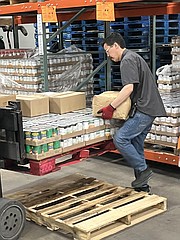Consumers feel the pangs of high food prices
With gas and food prices increasing by seemingly endless margins, it's no surprise that Americans are experiencing the worst case of inflation since 1981.
An average increase of just more than 10% in food costs nationwide within the past 12 months has left Kootenai County residents feeling the burn.
Some families have reported their grocery bills have at least doubled, and they’re struggling to keep up. Other local shoppers are making considerations about their diets to keep their grocery bills affordable.
“I’m becoming intentional about using what’s in the freezer and cupboards,” Post Falls resident Laurinda Burch said. “It’s become necessary to do without.”
Everyone in the U.S. has been dealing with these growing prices, but what is causing this rampant inflation?
Sky-high gas prices, scrambling supply chains, tight labor markets and political conflicts are a few factors in a perfect storm driving up the cost of goods in the U.S.
According to the Bureau of Labor Statistics, gas costs have gone up nearly 50% since last year.
Those growing gas prices have increased the cost of every step of an already struggling supply chain.
A side effect of the brief 2020 recession, the global supply chain is bent out of shape. With many Americans spending less in the wake of the pandemic, factories closed and supply chains scaled back in response. The rapid recovery of the U.S. economy after COVID-19 saw many Americans returning to their old spending habits and beyond, but the scaled-back supply chain could not meet their pace. The supply chain is only now starting to recover.
Another major factor of inflation is the tightening U.S. labor market.
Unemployment is at 3.6%. Even with the large number of Americans rejoining the labor force, there is still a major labor shortage in the U.S. This labor shortage has increased starting wages, an incentive to attract more workers, but these rising wages contribute to increased costs of goods.
Another major cause of increasing inflation is Russia's invasion of Ukraine.
The loss of trading partners in Russia and Ukraine has caused economic issues that have spread to every corner of the world. Without Ukrainian agriculture, the Indian government decided it was in its best interest to cancel all wheat trade. Year-to-date wheat futures have increased by more than 60%.
As so many factors drive up food prices, a future where prices return to normal may seem distant.
"Excess demand is a recipe for higher rates,” said economist John Mitchell, of Hayden. "The cure for high prices is high prices.”
In theory, high prices lead consumers to find cheaper alternatives or forgo the goods, but it is nearly impossible to stay entirely out of the food market.
To combat high food costs, consumers are economizing by finding alternatives at the grocery store, eating out less and even growing some food of their own.
This change in habits drives down prices by decreasing demand for the more expensive goods being avoided. However, for people struggling to make ends meet, these actions may not be possible.
Those who are out of the labor force and unable to enjoy the increased wages are at the most significant detriment.
“They are facing a lot of need,” said Eric Williams of Second Harvest, a Spokane-based nonprofit that supplies a network of partner food banks in eastern Washington and North Idaho.
Williams said Second Harvest’s quarterly reports indicate growing food insecurity throughout the region.
What can people facing food insecurity do in response to rising food prices?
For one, the national Supplemental Nutrition Assistance Program (SNAP) aims to assist in the form of what many know as “food stamps." Idaho is one of many states underutilizing SNAP. Many Idahoans who qualify for SNAP do not even apply.
For those who do not qualify for SNAP or those who still need more than SNAP allows, local food banks can help. Second Harvest, “a food bank for food banks," distributes food to local food banks to give to people in need.
“We're fortunate to be located where we are,” Williams said.
Spokane and Coeur d’Alene are lucky, Williams said, to have local growers where many worldwide are without.







